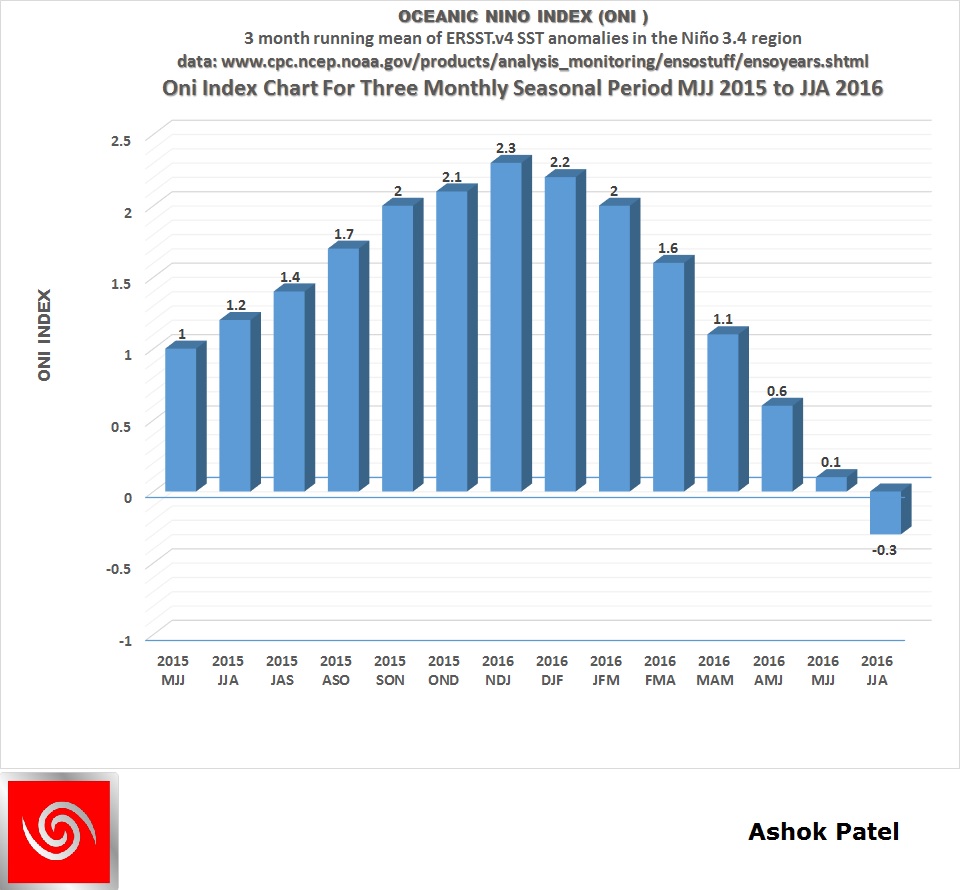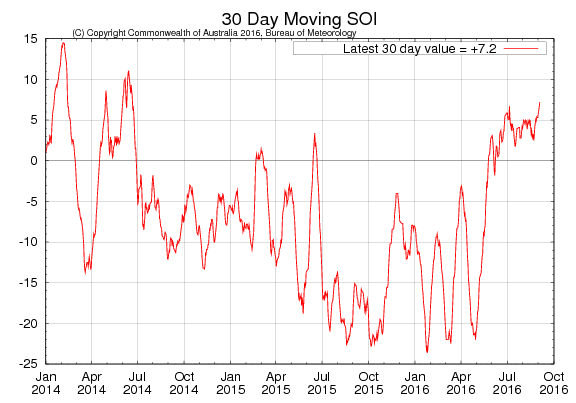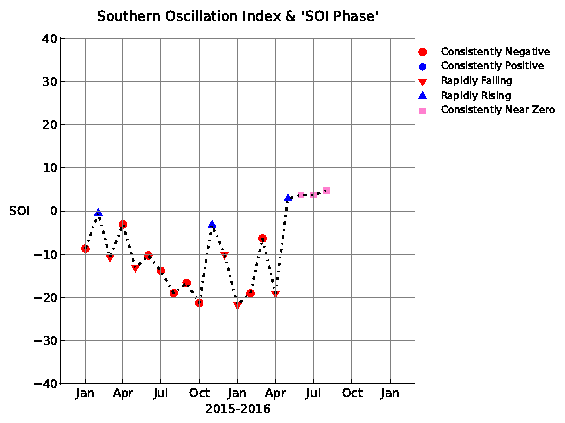El Nino Status on 6th September 2016
The ONI is based on SST departures from average in the Niño 3.4 region, and is a principal measure for monitoring, assessing, and predicting ENSO. Defined as the three-month running-mean SST departures in the Niño 3.4 region. Departures are based on a set of improved homogeneous historical SST analyses (Extended Reconstructed SST – ERSST.v4). The SST reconstruction methodology is described in Huang et al., 2015, J. Climate, vol. 28, 911-930).
CPC uses current Climatology based on 1986-2015 which has recently been changed from base years 1981-2010. Explanation about Climatology base years change is given here.
NOAA Operational Definitions for El Niño and La Niña El Niño: characterized by a positive ONI greater than or equal to +0.5ºC. La Niña: characterized by a negative ONI less than or equal to -0.5ºC. By historical standards, to be classified as a full-fledged El Niño or La Niña episode, these thresholds must be exceeded for a period of at least 5 consecutive overlapping 3-month seasons.
CPC considers El Niño or La Niña conditions to occur when the monthly Niño3.4 OISST departures meet or exceed +/- 0.5ºC along with consistent atmospheric features. These anomalies must also be forecast to persist for 3 consecutive months.
The current El Nino event ended at the end of July 2016. Due to change in Climatology from 1981-2010 to 1986-2015 there is again a change in the date as to when a full fledged El Nino was confirmed which now stands as at the end of February 2015 considering the SST departures from average in the Niño 3.4 region based on Extended Reconstructed SST – (ERSST.v4). The graph below shows that at the end of August 2016 an ENSO neutral conditions exists, the last available 3 monthly season being JJA 2016 which is -0.3ºC. Technically a full fledged La Nina can not develop during the year 2016, relying on the official NOAA definition for La Nina, because there has not been a single 3 -monthly season with La Nina thresh hold and now only four 3-monthly seasons are left after August 2016.
જુલાઈ 2016 આખર થી ‘એલ નિનો’ ખતમ થયો. જુલાઈ ની જેમ ઓગસ્ટ 2016 માં પણ ‘એન્સો ન્યુટ્રલ’ પોઝિશન છે. 2016 ના ભારતીય દક્ષિણ પશ્ચિમ ચોમાસા દરમિયાન ‘લા નીના’ પ્રસ્થાપિત નહિ થાય. તેવીજ રીતે 2016 માં વિધિવત સંપૂર્ણ ‘લા નીના’ શક્ય નહિ બને.
Latest Oceanic Nino Index (ONI) Graph till August 2016
The Table below shows the monthly SST of Nino3.4 Region and the Climate adjusted normal SST and SST anomaly for last two years. Climate Base 1986-2015.
Period Nino3.4 ClimAdjust YR MON Temp.ºC Temp.ºC ANOM ºC 2014 8 26.90 27.02 -0.12 2014 9 27.03 26.94 0.09 2014 10 27.25 26.91 0.34 2014 11 27.51 26.88 0.63 2014 12 27.40 26.80 0.61 2015 1 27.22 26.61 0.61 2015 2 27.25 26.80 0.45 2015 3 27.79 27.32 0.47 2015 4 28.59 27.86 0.73 2015 5 28.83 27.98 0.85 2015 6 28.70 27.76 0.94 2015 7 28.50 27.37 1.13 2015 8 28.47 27.02 1.45 2015 9 28.62 26.94 1.68 2015 10 28.86 26.91 1.95 2015 11 29.14 26.88 2.25 2015 12 29.04 26.80 2.24 2016 1 28.94 26.61 2.33 2016 2 28.89 26.80 2.09 2016 3 28.87 27.32 1.55 2016 4 28.97 27.86 1.11 2016 5 28.60 27.98 0.62 2016 6 27.82 27.76 0.06 2016 7 26.99 27.37 -0.38 2016 8 26.47 27.02 -0.55
June, July & August 2016 SST anomaly for Nino3.4 region is used to calculate the latest ONI Index for JJA 2016 as -0.3ºC. Since the latest ONI Index is below +0.5ºC and above -0.5ºC, ENSO neutral conditions prevail till end of August 2016.
CPC considers El Niño or La Niña conditions to occur when the monthly Niño3.4 OISST departures meet or exceed +/- 0.5°C along with consistent atmospheric features. These anomalies must also be forecast to persist for 3 consecutive months.
Southern Oscillation Index
As per BOM, Australia:
The latest 30-day Southern Oscillation Index (SOI) to 28 August 2016 is +4.9, within the neutral ENSO range. The 30-day SOI had dropped as low as +2.5 during the past fortnight. However, SOI was 7.2 on 4th September 2016.
Sustained positive values of the SOI above +7 typically indicate La Niña while sustained negative values below −7 typically indicate El Niño. Values between about +7 and −7 generally indicate neutral conditions.
SOI Monthly graph up to August 2016 as per The Long Paddock – Queensland Government.
SOI was +4.67 at the end of August 2016 and +7.08 on 5th September 2016 as per The Long Paddock – Queensland Government.
Summary by: Climate Prediction Center / NCEP Dated 1st August 2016
ENSO Alert System Status: La Niña Watch ENSO-neutral conditions are present.* Equatorial sea surface temperatures (SST) are near or below average in the east-central and eastern Pacific Ocean. La Niña is slightly favored to develop during August-October (ASO)2016, with about a 55-60% chance of La Niña during the fall and winter 2016-17.*
* Note: These statements are updated once a month (2nd Thursday of each month) in association with the ENSO Diagnostics Discussion, which can be found by clicking here
As per BOM -Australia 30th August 2016
Pacific remains ENSO-neutral – A La Niña WATCH remains in place.
In the tropical Pacific Ocean, sea surface temperatures are cooler than average, though remain well short of La Niña levels. In the atmosphere, there has been little change in trade winds or cloudiness, indicating little or no coupling between the atmosphere and ocean. As a result, cool sub-surface temperatures have eased slowly towards normal. International climate models suggest neutral to weak La Niña levels for the remainder of the year. A La Niña WATCH remains in place.



Sir Gujarat maa varsad thashe
Chomasu haju chalu chhe.
Sir
IOD NU STATUS SU CHHE?
Negative ane raheshe.
Sir, DT.10,11,12 mate tame batavelu nullschool Gujarat mate ganu saru batave chhe (700&850) ke amane jota barabar nahi avadtu hoi?
SU saru batave chhe ? pavan ke varsad ?
Sorry sir amne jota j nahi avadtu hoi pavan ane varsad alag-alag jovay te khabar j nathi!
Sir aa chomasha ma aapna aarbi samundra ma kem Kay current nathi aal nino nade che
El Nino nathi. Aney hoi toe te Gujarat maate na hoi !
Sir Jo aavnara 4 ke 5 divas ma chomasu northwest Rajasthan mathi viday lai ley ane tyare chomasu dhari Himalayas upar hoy to pasi dhari ni normal position kutch upar ek sedo aavi sake?
Normal position Rajasthan Barmer aaspaas hoi chhe.
Minapur ma kale shanje 5:45 thi 7:45 lagbhag 100 thi 120 mm varshad thayo!
Ta.chuda di.surendranagar
sor
skymet weather na gujrat ma uac batave de to te labhdayak se??!
aagahi aapel chhe.